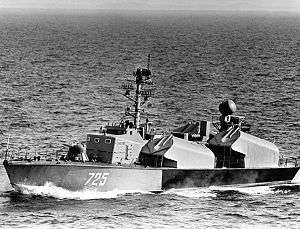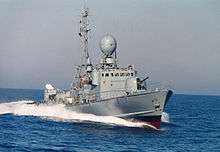Missile boat

A missile boat or missile cutter is a small warship armed with anti-ship missiles. Being a small craft, missile boats are popular with nations interested in forming an inexpensive navy. They are similar in idea to the torpedo boats of World War II; in fact, the first missile boats were modified torpedo boats replacing two or more torpedo tubes with missile tubes. The doctrine behind the use of missile boats is based on the principle of mobility over defence and firepower. The advent of proper guided missile and electronic counter measure technologies gave birth to the idea that, because a guided missile (such as a guided artillery shell) is far more accurate than an unguided missile (such as an unguided artillery shell), warships should now be designed to outmaneuver their enemies and get to a better position first.
Moreover, increasing the potency of naval artillery requires employing larger projectiles, which necessitates larger (and thus heavier) naval guns and consequently, larger platforms to carry these guns and absorb their recoil. This trend culminated in the giant battleships of WWII. The ability to deploy anti-ship guided self-propelled warheads from small, maneuverable platforms partially negates the advantages that were provided by larger ships in the era before the advent of guided self-propelled warheads.
A small missile boat, when equipped with sophisticated guided anti-ship missiles, can pose a negligible to moderate threat to even the largest of capital ships, and do so at much greater ranges than is possible with torpedoes.
Design
Missile boats were invented and first manufactured in the Soviet Union. The significant characteristics of the boat were an extremely thin skinned 200 ton hull, propelled by very high power engines to give a high speed of 34 knots. Being small, the boat had a very small radar cross section. Its sophisticated radar was more advanced than any other known radar—it enabled the missile boat, with its low radar reflectivity, to detect a larger ship well before the latter was even aware of its presence, to fire its missiles and to speed away faster than any other ship.
The Russian naval architects had deliberately designed these characteristics, so as to give the small boats this advantage against much larger American naval ships should they attempt to attack the Russian coast. The boats were designed for, and only had limited endurance for, coastal operations.[1]
History
The first few missile boats were originally torpedo boats, with the torpedo tubes replaced by missile launchers. Again, small fast craft could attack and destroy a major warship. The idea was first tested by the Soviet Union as Project 183R which, in August 1957, produced the Komar class which mounted two P-15 Termit missiles in box-launchers on a 25-metre (82 ft) hull backed with a twin 25 mm gun. Four diesels gave the Komars 4,800 bhp (3,600 kW) and a top speed of around 40 knots (74 km/h; 46 mph). Endurance was limited to 1,000 nautical miles (1,900 km; 1,200 mi) at 12 knots (22 km/h; 14 mph) and the vessels had supplies for only five days at sea. 110 Komar-class vessels were produced, while over 400 examples were built of the following Osa class with a significant portion of the total being sold to pro-Soviet nations.
The first combat use of missile boats was by the Egyptian Soviet-built Komar class craft, which fired four Styx missiles on the Israeli destroyer Eilat on October 20, 1967, shortly after the Six Day War, causing the latter's sinking with 47 dead.[2]

The Soviet FACs prompted a NATO response, which became more intense after the sinking of Eilat. The Germans and French worked together to produce a new FAC, resulting in 1968 in the Combattante II class. Built on a 47-or-49-metre (154 or 161 ft) hull with 12,000 bhp (8,900 kW) of MTU diesel engines driving four shafts; a common layout would have four MM-38 Exocet missiles in two sets of two box launchers, in line and offset to the right and left with a 76 mm gun forward and 40 mm twin guns aft. Built until 1974, a total of 68 Combattante IIs were launched. The design was immediately followed by the Combattante III (1975–90) which added 9 metres (30 ft) to hull length but kept the same armament (+ two twin 30 mm guns), 43 of this type were produced. A great many other shipyards produced their own versions of the Combattante, notably the Israeli Sa'ar/Reshef variants.
Missile craft have seen action in various conflicts since their development.
The Indian Navy's 25th Missile Boat Squadron, consisting of vessels from the Vidyut class, played a crucial role in the highly devastating Indian attacks on Karachi in December 1971. The two key operations in which these vessels played an active role, were Operation Trident and Operation Python.The attacks destroyed half of the Pakistani Navy[3] and most of Pakistan's fuel reserves in the port's fuel storage tanks which clearing way for decisive victory of Indian Armed Forces in the Western Theater during the Indo-Pakistani War of 1971.[1][4]
The world's first naval missile battles between warships occurred between Israel Navy Sa'ar 3-class missile boats and Sa'ar 4-class missile boats (using indigenously-developed Gabriel missiles), and Syrian Osa class missile boats and Komar class missile boats during the October 1973 Yom Kippur War. The first of these engagements became known as the Battle of Latakia. In these battles, some fifty Gabriels and a similar number of Styx missiles were fired, and seven Syrian craft were sunk, with zero losses for the Israelis.
At the Battle of Bubiyan in 1991 Iraqi FACs were destroyed by British air-to-surface missiles. Later designs, such as the German Gepard class and Finnish Hamina class are equipped with surface-to-air missiles and countermeasures.
Size has also increased, some designs reaching up to corvette size, 800 tonnes including a helicopter, giving them extended modes of operation. In April 1996 during Israel's Operation Grapes of Wrath, IDF naval forces used Sa'ar 4 and Sa'ar 4.5 boats to shell the Lebanese coast with 76 mm fire, in conjunction with artillery and air attacks.
Current situation
Iran and North Korea have some of the largest numbers of FACs in operation today. North Korea alone operates more than 300,[5] while Iran have been seen developing "swarm boats" to be used as harassing vessels in the heavily contested littoral waters of the Persian Gulf. To counter the threat, the US Navy has been developing an ASUW Littoral Defensive Anti Surface Warfare doctrine, along with vessels such as the littoral combat ship.
See also
- List of missile boat classes
- Fast attack craft
- Ballistic missile submarine (sometimes called a "missile boat")
References
- 1 2 http://www.globalsecurity.org/military/world/india/viyut.htm
- ↑ http://www.globalsecurity.org/military/world/israel/k40-eilat.htm
- ↑ Ali, Tariq (1997). Can Pakistan Survive? The Death of a State. Verso Books. ISBN 9780860919490.
- ↑ S.M.Nanda (2004). The Man Who Bombed Karachi. HarperCollins India. ISBN.
- ↑ Hy Sang Lee: North Korea: A Strange Socialist Fortress, p. 85
External links
![]() Media related to Missile boats at Wikimedia Commons
Media related to Missile boats at Wikimedia Commons